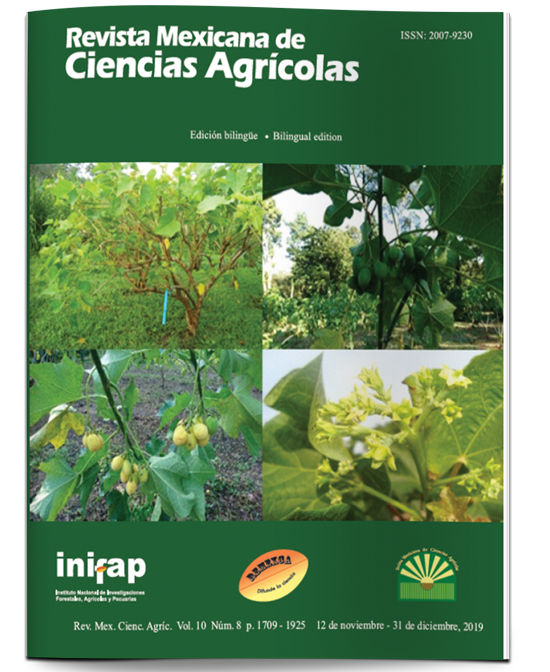Biofertilizers of rhizobacteria in the growth of Poblano chili seedlings
DOI:
https://doi.org/10.29312/remexca.v10i8.1548Keywords:
Capsicum annuum, biotechnology, inoculantsAbstract
Poblano chili (Capsicum annuum L.) is a widely consumed variety in our country, but there are several problems that affect its cultivation and production. Considering the above, the objective of this research was to elaborate and compare the effect of two biofertilizers with rhizobacteria on the growth of Poblano chili seedlings. The research was conducted at the Postgraduate College, Montecillo Campus in the years 2015-2016. The work was carried out in three stages: 1) selection of culture media and growth dynamics of four strains of rhizobacteria; 2) elaboration of two bioformulations using alginate and peat pearls as carriers; also, the viability of the rhizobacteria was evaluated for five months; and 3) evaluation of the effect of bioformulations in promoting the growth of Poblano chili seedlings. Serratia strains showed the highest growth in the TBS culture medium, while Pseudomonas strains had high growth in Luria-Bertani broth. The stationary phase of the Pseudomonas strains was reached between 24-48 h and that of the Serratia strains between 12-44 h. The shelf life of the two formulations was maintained from 1 x 1012 to 1 x 109 CFU for five months. The application of alginate beads in the seedlings stimulated seedling growth up to 35% with respect to the control. The application of biofertilizers based on alginate and peat pearls is a good option to promote the growth of chili seedlings.
Downloads
Published
How to Cite
Issue
Section
License
The authors who publish in Revista Mexicana de Ciencias Agrícolas accept the following conditions:
In accordance with copyright laws, Revista Mexicana de Ciencias Agrícolas recognizes and respects the authors’ moral right and ownership of property rights which will be transferred to the journal for dissemination in open access. Invariably, all the authors have to sign a letter of transfer of property rights and of originality of the article to Instituto Nacional de Investigaciones Forestales, Agrícolas y Pecuarias (INIFAP) [National Institute of Forestry, Agricultural and Livestock Research]. The author(s) must pay a fee for the reception of articles before proceeding to editorial review.
All the texts published by Revista Mexicana de Ciencias Agrícolas —with no exception— are distributed under a Creative Commons License Attribution-NonCommercial 4.0 International (CC BY-NC 4.0), which allows third parties to use the publication as long as the work’s authorship and its first publication in this journal are mentioned.
The author(s) can enter into independent and additional contractual agreements for the nonexclusive distribution of the version of the article published in Revista Mexicana de Ciencias Agrícolas (for example include it into an institutional repository or publish it in a book) as long as it is clearly and explicitly indicated that the work was published for the first time in Revista Mexicana de Ciencias Agrícolas.
For all the above, the authors shall send the Letter-transfer of Property Rights for the first publication duly filled in and signed by the author(s). This form must be sent as a PDF file to: revista_atm@yahoo.com.mx; cienciasagricola@inifap.gob.mx; remexca2017@gmail.
This work is licensed under a Creative Commons Attribution-Noncommercial 4.0 International license.



